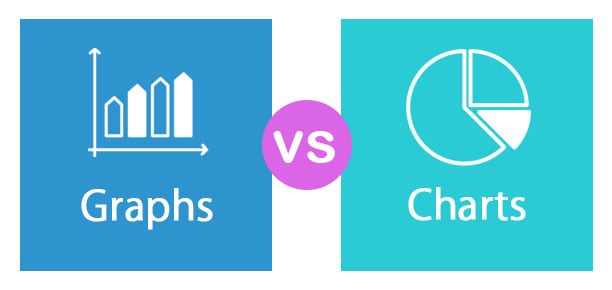Updated October 12, 2023
Difference Between Graphs vs Charts
Graphs and charts are almost similar terminology and are used widely by corporates or in other business proposals and presentations for various purposes, etc., for representing numbers, reports, performance, etc. Graphs vs charts, although often used interchangeably, differ slightly in their definitions and usage. A graph is a type of diagram and a mathematical function that can also be used as a diagram of the data, which is statistical.
A diagram that shows the relation between the variable quantities, typically of 2 variables, and where each will be measured along 1 of a pair of axes at the right angles. On the other hand, a chart is a form of graphic representation of the data, whereas a line chart is one form. A chart represents the numeric data in a tabular format and can also represent functions or some qualitative structure and provide different information.
Head-to-Head Comparison Between Graphs vs Charts (Infographics)
Below are the top 6 differences between Graphs vs Charts:
Key Differences Between Graphs vs Charts
Both Graphs vs Charts are popular choices in the market; let us discuss some of the major differences:
- The major key difference between graphs vs charts is that graph is a diagram representing a system of interrelations or connections among 2 or more 2 things by several distinctive lines, dots, bars, etc. In contrast, the chart, as stated earlier, is a type of graphical representation of the information or the data, in which “the data that is represented by the symbols, like the lines in a line chart, bars in the bar chart, or the slices in a pie chart.”
- Graphs are the subset of the charts as the charts are the larger version of the same.
- Graphs represent the mathematical connections or interrelationships between the different data sets, whereas charts represent the diagrams where one can find the depicted information or the data.
- As mentioned earlier, all graphs are charts, but on the flip side, not all charts are.
- Charts are the larger methods for depicting or representing the data or information. At the same time, to the contrary, the graphs provide one of those methods (that charts use to describe the information) by presenting the data in a visual format.
- A chart will illustrate the information or data using only one quantitative coordinate. In contrast, on the flip side, a graph relates one qualitative variable to the other quantitative variable, and generally, its time.
Graphs vs Charts Comparison Table
Below is the 6 topmost comparison between Graphs vs Charts:
| Basis of Comparison |
Graphs |
Charts |
| Basic Definition | A graph represents a system of interrelations or connections among 2 or more things by several distinctive lines, dots, bars, etc. | A Chart is a kind of graphical representation of the data in which “the symbols, like the lines in a line chart, bars in the bar chart, or the slices in a pie chart, represent the data.” |
| Representation | Graphs will show the mathematical connections or interrelationships between the sets of data. | Charts will present the information or the data in the form of diagrams, graphs, or tables. |
| Are they the Same? | All kinds of graphs and charts; hence graphs are one kind of chart. | All kind of charts does not make a graph. |
| Scope | Graphs also provide the visual form by presenting data in a visualized format using one of those methods (i.e., the larger group of the charts). | Charts are the larger methods used to present the data or the information. |
| What do They do? | Graphs will take pictures of the numerical data or numerical information. | Diagrams in the charts can show sequential events, such as the history of the U.S.A. government’s nutritional guidelines or the rock cycle. |
| Their Types | Pie charts, bar graphs, line graphs, etc., are used for many different purposes. | As stated earlier, graphs are the subset of charts; hence, charts do not have their type, but there are examples of charts, such as using the maps to include drunk driving statistics or volcano and earthquake locations. |
Conclusion
Charts are the most appropriate for quantitatively comparing the data groups or the discrete categories. The most popular charts are bar, column, line, and pie charts. A bar chart will be handy for displaying the information or the data about gender, occupation, ethnicity, types of discharges, and treatment categories. Bar charts are helpful or appropriate for displaying categorical information or categorical data. Bar charts will compare groups or categories by using some of the quantitative measurements.
On the other hand, while graphs can be simple or quite complicated, individuals must always select them to represent their information or data as clearly as possible. Sometimes the 2 graphs can be better than one if each shows a different aspect of the same information or the data set. Not all the graphs are created equal, however. The kind of graph that will be used will depend upon the type of data set.
The most commonly used graphs include histograms and frequency polygons. Quantitative continuous data can be displayed via a graph. Charts are for when there’s one qualitative variable (Like the type, gender, or preference) and 1 quantitative variable (Like age, time, or amount). These shall include bar charts and pie charts. At the same time, the graphs are for when one has 2 quantitative variables.
One may not find graphs in the following kind of charts.
- Eye testing chart
- Look-up chart
- Pie chart
Recommended Articles
This has been a guide to Graphs vs Charts. Here we discuss Graphs vs Charts key differences with infographics and comparison table. You may also have a look at the following articles to learn more –




